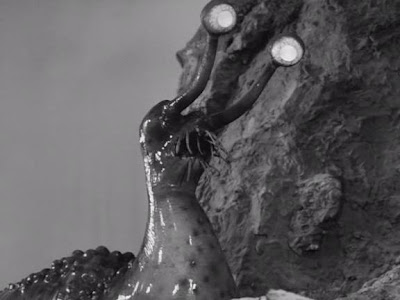
ULTRA-Q(1966, Japan, TV)
It was dreamt up by the special effects mastermind behind the Godzilla films, Eiji Tsuburaya, as he was trying to find a format for his special effects techniques in a TV show. He was aiming for the same mixture of fantasy and mystery as the US hit The Twilight Zone, but because of his visual effects for Toho sci-fi films, like the Godzilla series, and possibly because they knew he owned all the monster suits, each episode of Ultra-Q usually has a giant monster in it.

But I really wanted to see Ultra-Q, to see more of Tsuburaya's special effects and unique monsters, some of whom have reappeared in later Ultraman series. There was even a recent update of Ultra-Q called Dark Fantasy, but it was a fairly cheap tribute, shot on video, and didn't look as nearly as impressive as the 1966 show, when the special effects rival his film work.

Ultra-Q episodes can either be mini-monster movies, short disaster epics, or surreal childhood fantasies. But the imagination and extensive special effects, not to mention the lively camerawork, fast editing and jazzy score, make it enjoyable even without subtitles. The series was made in black-and-white, unlike Ultraman, which helps makes the composite visual effects and back projection look more convincing, which adds to the charm.
While the series ended up being aimed at children, the high production values, adult cast and scary weirdness makes it as interesting to adult fans as sixties Godzilla movies, for instance.
Indeed, watch out for guest appearances from movie monsters Godzilla, King Kong, Manda and the gang, sometimes dressed up in disguise, and marvel at the new creations such as a giant snail with glowing eyes - a ridiculous and unique creature that still manages to creep me out. How'd you like to see that staring through your window at night?

I baulked at paying for the Japanese boxset that was issued in 2005, but in 2008 the same DVDs were reissued at a far more affordable price. There are seven volumes, each with four episodes on. CD Japan and YesAsia sell them, but be careful not to order the recent remake Ultra Q - Dark Fantasy, or the 2005 editions (they have black and white covers) as they cost twice as much as the new issues. Japanese DVDs are all NTSC, but coded region 2. There are no English subtitles on either release.
For more about the life and works of visual effects mastermind Eiji Tsuburaya, August Ragone's extensive and superbly illustrated biography is still in the shops.
Update November 2013
Shout Factory have released the entire series with English subtitles for English-speaking fans to finally enjoy this unique series. Despite Japan releasing the series yet again, but colorised, it was relief to see this American boxset presents all episodes in the original black-and-white, over five discs.

No comments:
Post a Comment